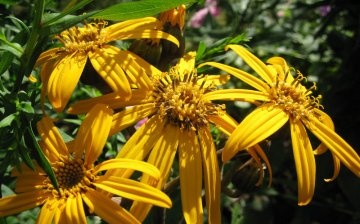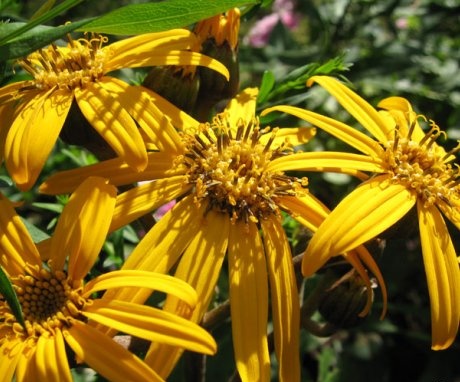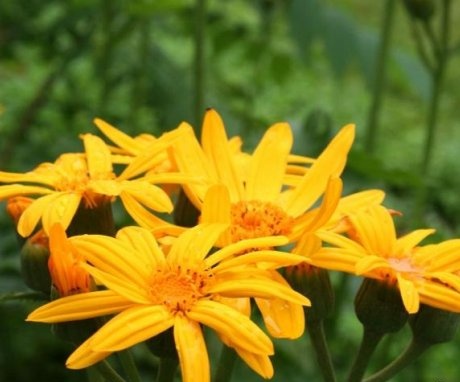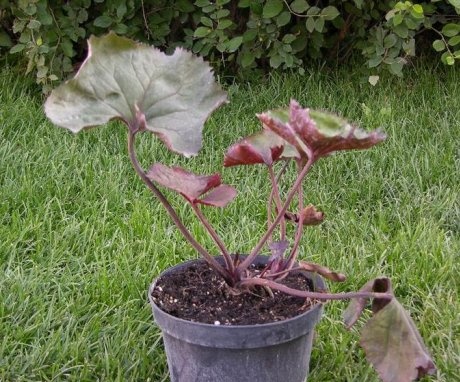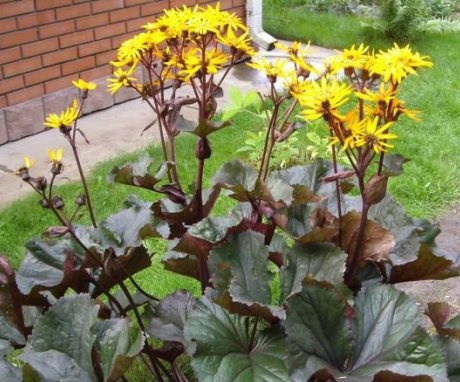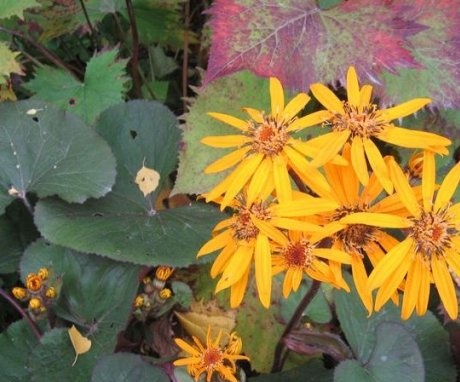Buzulnik "Othello" - unpretentious tall shrub
Ligularia (lagularis) is translated from Latin as tongue. It earned this name thanks to its beautiful curved petals, which, during flowering, resemble the play of tongues of flame.
The plant is native to Southwest China, where it is distributed in the wild. Due to its beautiful appearance, the flower attracted the attention of breeders, and in the 20th century, work began on its selection. Every year, new varieties of buzulnik began to appear, which differed not only in flowers, but also in the shape of the leaves. One of the brightest representatives is the toothed buzulnik, namely the "Othello" variety, which has an unusual structure of the leaf blade and rather large bright flowers.
Content:
- Othello buzulnik exterior
- Overview of plant propagation methods
- Planting stages
- Care features
- Protection against diseases and pests
Othello buzulnik exterior
Buzulnik serrated is in demand among gardeners due to the large size of the bush with beautiful leaves and spectacular flowers, as well as a long period. flowering.
Buzulnik toothed owes its name to the structure of leaves, similar to deer antlers. At the beginning of the season, they have a dark purple color, and over time, their front part turns green with a purple tint, and the inner sides of the front plate acquire a purple color with bright red veins that resemble blood vessels in appearance.
The plant blooms with racemose inflorescences that delight the eye from August to October.
Buzulnik serrated is represented by two popular varieties - "Othello" and "Desdemona", which differ in color and leaves and flowers. If "Desdemona" is the owner of delicate light green leaves with a lilac back and red-orange flowers, then "Othello" is distinguished by bright orange inflorescences and rich green glossy leaves with a crimson border on top and purple with a red mesh of veins - below. Plants show themselves especially effectively in the presence of wind, which is stirring up the leaves and the buzulnik plays with variegated shades.
Buzulnik "Othello" is a rather large plant that grows up to a meter in height. Bright chamomile flowers with a diameter of 12-13 cm are collected in paniculate bouquets. The flower is quite frost-resistant, but in extreme cold it can freeze slightly. Therefore, in cold regions, you should take care of shelter for the winter.
Overview of plant propagation methods
All types of buzulnik can be propagated in two ways - by seed and by dividing the bush. Experienced flower growers often choose the second method, because it is easier and more reliable to do it, and the sown seeds partially freeze out and additional conditions must be created for maximum germination.
Seed reproduction. Choosing this method, you need to be prepared for the fact that it will take a lot of work and patience to see the results. A buzulnik planted in this way will delight with flowering only after 3-4 years. When seed propagation, certain rules must be followed:
- Seed collection. The procedure is carried out after the seeds are fully ripe after flowering.
- The collected seeds must be thoroughly dried.
- Buzulnik is sown either directly into the open ground, or in separate containers to obtain seedlings... Also, the plant can reproduce by self-seeding.
- Seed material is buried into the ground by no more than two centimeters.
In winter, the seeds will be exposed to natural stratification... It also does not hurt to cover the plantings to prevent the seeds from freezing. In the spring, the first flower bores appear, but the plant will develop before the first flowering within three to five years. If the seeds were sown in containers, then transplanting seedlings into open ground should be carried out when the soil warms up a little.
Dividing the bush... This method is used more often, because with a little effort, you can quickly admire the results of labor. In addition, the division of the bush allows you to preserve the decorative heredity from the mother plant.
For such reproduction, you need to follow a number of simple rules:
- dividing the bush is preferable in the spring when Othello is actively growing. You can also carry out the procedure at any time until autumn.
- for the procedure, a strong healthy adult bush is chosen, which has already begun to release leaves from under the ground
- simplicity of manipulation lies in the fact that the plant is not completely dug up, but simply cut off part of the piece with a suitable tool
- the cut off fragment is dug up, and the vacated space is filled with nutritious soil and watered abundantly
- the excavated part of the plant is carefully washed with running water and cleaned. Then they are divided into several more fragments so that on each there is a growth bud
- the resulting bushes are planted in prepared holes in a permanent place
Dividing the bush allows you to get a full-fledged ornamental plant after a year. Also, the division can be carried out with obligatory flower transplants, which are carried out every five years.
Planting stages
Buzulnik is a shade-loving plant and this should be taken into account when choosing a place for planting. Also, the flower is quite picky about moisture. It is preferable to plant "Othello" along the walls and decorate the background of the flower bed with them. The flower also looks impressive in single plantings between trees.
The buzulnik puts forward special requirements for the composition of the soil.
It should be rich in nutrients and sufficiently hydrated. Othello can grow in heavy clay soil with poor or no drainage. Decently tolerates temporary flooding. Buzulnik "Othello" belongs to undemanding plants, but in order to obtain decorative qualities and full development of a flower, a number of preparatory procedures must be carried out.
The type of plant largely depends on the correct choice of planting material, location in the garden and on the composition of the soil:
- The choice of planting material. Purchase seedlings or the seeds need in special places. These can be specialized nurseries or shops. Planting material should be chosen according to the appearance of a young plant. It must be intact and free from signs of disease. Dry and broken roots and stems are not allowed on the seedling.
- Location. when choosing a site for planting, you need to remember that buzulniks prefer shaded areas. The sun can negatively affect the decorative qualities of the plant. The flower will feel good under the canopy of trees, in the shade of the fence and buildings, as well as along the banks of an artificial or natural reservoir.
- Soil composition. The preparation of the beds is carried out immediately before planting the flower. You need to dig well the soil to the depth of the shovel bayonet. Top dressing is applied during planting or plant transplantation.
Planting is recommended to be carried out in the spring, when the plant has not yet begun to bloom its leaves. In the prepared place, holes are dug according to the scheme 40x40 cm with an interval of at least a meter.Seedlings are placed in the holes, straightening the roots, and covered with soil mixture, which includes garden soil, humus, superphosphate and wood ash... It is necessary to ensure that the buds protrude slightly above the surface of the ground. After planting, the plants are watered, and their flowering may occur in the same year.
Care features
The plant itself is unpretentious, but in order to achieve abundant and lush flowering and external decorativeness of the buzulnik, you should pay a little attention to the flower and take into account its needs:
- Irrigation. Irrigation should be abundant and frequent enough. It is necessary to keep the soil constantly moist. In case of mild heat, watering is carried out every 5-7 days, and when it is dry weather - as required, preventing the topsoil from drying out. Also, in dry weather, spraying will not hurt the buzulnik, which is carried out in the morning or evening.
- Fertilization. Othello loves fertile soil, which is rich in nutrients. The first feeding is carried out during planting, when the required amount of superphosphate, wood ash and humus is added. Further, it is enough to apply fertilizers once a year. In the spring, the soil under each bush is fertilized with a solution mullein... And after flowering, it is advisable to add humus to provide the plant with strength for wintering.
- The soil around the bushes should be constantly loosened to provide oxygen to the roots. The number of such procedures can be reduced by mulching the beds with dry peat. This procedure also helps to retain moisture longer, so you should not neglect it.
- Bush formation. Pruning Buzulnik bushes "Othello" should be carried out if seed is not needed. In addition, this procedure helps to maintain decorative qualities for a longer time. During the procedure, cut off the faded inflorescences. This helps to rejuvenate the plant.
- In the process of active growth, "Othello" can greatly grow and stretch, and this will lead to the loss of its decorative appearance, because during flowering, the peduncles can bend to the ground. To prevent this from happening, you should take care of the support and, if necessary, tie the plant to it.
Protection against diseases and pests
Nature has endowed the buzulnik with excellent health and immunity to many diseases and attacks of harmful insects. But in the spring, the plant should be protected from slugs that eat up the leaves.
For prevention, sprinkle the soil under the flowers with superphosphate granules and remove the insects by hand.
Rarely enough, a plant can infect powdery mildew... If signs of an ailment are found, the buzulnik should be sprayed with manganese solution or colloidal sulfur.
Subject to the simple rules of agricultural technology, the buzulnik "Othello" will decorate the garden with bright flowers for a long time. It is enough just to provide the plant with abundant watering and sufficient nutrition.
More information can be found in the video:




